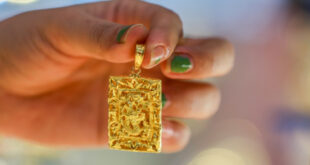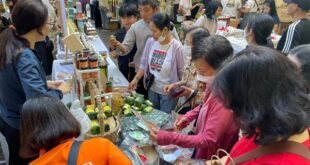The southernmost province of Ca Mau is not only rich in forest and ocean resources but also famous for countless delicacies that captivate visitors.
Nam Can crab
Nam Can crab, named after a rural district, is one of the specialties that nature bestows on Ca Mau. The crabs are raised in a natural ecological environment in shrimp ponds located in coastal alluvial areas. They are famed for their sweet and firm meat, rich tomalley and high nutritional and economic value.
 |
|
Steamed Nam Can crab with dipping chily sauce. Photo by VnExpress/Ha Lam |
There are many delicious Nam Can crab dishes, though locals say steamed crab best retains the natural sweetness of the meat and tomalley, combined with the sour, savory and spicy dipping sauce.
Giant mudskipper
A specialty of the mangrove forests of Ca Mau, only found in the wild, mudskippers are known for their rich and chewy meat. This fish has high nutritional value and no small bones.
Famed dishes include sour soup, braised mudskipper with pepper and fried mudskipper, though the best is still grilled mudskipper with salt and pepper. The fish is marinated with a little bit of salt and chili, then placed on a charcoal grill on medium heat and cooked evenly until the skin turns golden.
 |
|
Charcoal-grilled mudskippers with salt and lemon. Photo by VnExpress/Ha Lam |
In addition, Ca Mau locals also produce dried mudskipper to enjoy all year round, typically with tamarind sauce.
Rach Goc sesarmid
Sesarmid (ba khia in Vietnamese) is very familiar to Ca Mau residents located in dense forests near rivers or the sea. During the rainy season, sesarmids appear at night in large numbers in water coconut trees and are easily harvested.
The best sesarmid can be found in Rach Goc, a town of Ngoc Hien District.
 |
|
Fermented sesarmids with garlic. Photo by VnExpress/Ha Lam |
A famous dish from sesarmids is fermenting them in salt walter in at least five days. The quality of the dish depends on the salinity of the salt water because if it is too low, the sesarmids will not be edible, but if it is too salty the dish will not taste good. Fermented sesarmids can be rinsed through boiling water and mixed with garlic, chili, lemon, sugar or mixed with star fruit.
Mantis shrimp
Ca Mau mantis shrimp are caught in large estuaries in Song Doc, Da Bac, Khai Long, Dat Mui and Nam Can. Mantis shrimp meat has a sweet, chewy taste, with a little saltiness of the sea.
 |
|
A dish of steamed mantis shrimp. Photo by VnExpress/Ha Lam |
Mantis shrimp can be grilled, roasted with garlic or salt. The simplest and most common method is steaming them with beer, coconut water or lemongrass, accompanied by salt, lemon and chili sauce. In addition, mantis shrimp can be dried.
Dried shrimp
Ca Mau locals believe Rach Goc or Bay Hap shrimp are the best for drying since they live in brackish water and alluvial estuaries, making their meat sweet and firm.
 |
|
Ca Mau shrimp after being dried. Photo by VnExpress/Ha Lam |
After the shrimps are caught, they are put in a pot of boiling water. If they stay too long in hot water, their meat would stick to the shell. The shrimp are usually boiled in the morning so they can spend more time in the sun. The drying process can last for a day or two.
Dried shrimp can be eaten with pickles or used in soup and salad.
U Minh dried snakeskin gourami
Snakeskin gourami (ca sac in Vietnamese) are a freshwater fish, mostly found in the U Minh Ha forest.
Snakeskin gourami is one of the types of fish living in fresh water, mostly found two areas, the U Minh Ha forest and the districts of the freshwater area in Ca Mau.
According to the locals, snakeskin gourami is usually caught and cooked in the dry season. This type of fish has to be dried to make delicious and unique dishes. To make a good dried snakeskin gourami they must be large and fresh then soaked in salted water for about an hour and then let dry for two sunny days at most, or else the fish will lose its signature aroma.
 |
|
Dried snakeskin gourami in Ca Mau. Photo by VnExpress/Ha Lam |
Ca Mau people store dried snakeskin gourami to eat all year round by burying it in a pot of rice to keep the meat red and the quality intact. Dried snakeskin gourami can be used to make many delicious dishes such as mango salad or grilled, served with cooked rice left cold, and coconut water.
Pickled bon bon
Bon bon, a Mekong Delta plant that grows in flooded field and tastes like young bamboo shoots or aparagus, appears during the water-rising season from June to November each year. After harvesting, their leaves are severed and a small knife is used to obtain the edible part of the stem to pickle. The plant is used to cook braised fish, stir-fry shrimp, hot pot and sour soup.
 |
|
Jars of pickled bon bon (yellowish white) sold along other kinds of pickles in a shop in Ca Mau. Photo by VnExpess/Ha Lam |
Many tourists buy pickled bon bon as gifts during their Ca Mau trip. Along National Highway No. 1, on both sides of the road in Cai Nuoc and Nam Can districts, there are many small shops selling this delicacy.
In addition to the seven specialties, Ca Mau also has other delights like U Minh forest honey, U Minh fish sauce hot pot and oysters.
- Reduce Hair Loss with PURA D’OR Gold Label Shampoo
- Castor Oil Has Made a “Huge” Difference With Hair and Brow Growth
- Excessive hair loss in men: Signs of illness that cannot be subjective
- Dịch Vụ SEO Website ở Los Angeles, CA: đưa trang web doanh nghiệp bạn lên top Google
- Nails Salon Sierra Madre
 VnExpress News The News Gateway of Vietnam
VnExpress News The News Gateway of Vietnam




